Annual Report Clearly Indicates Maine is Behind on Pay Compared to Rest of New England and National Data.
Every year the National Education Association releases the Rankings & Estimates Benchmark report. The comprehensive report provides comparative state data and national averages for a wide array of public K-12 education statistics, including average teacher salaries and per-student expenditures. Despite recent gains, Maine trails the rest of New England and nationally in educator pay, and inflation continues to outpace increases.
USA Averages
- National Average Teacher Salary
- $69,544
- National Starting Teacher Salary
- $44,530
- National ESP Average
- $35,995
Average Teacher Salary Top 3 States
- CALIFORNIA – $95,160
- NEW YORK – $92,696
- MASSACHUSETTS – $92,307
Want to see the complete Educator Pay Data report? Visit nea.org
Average Teacher Salary Bottom 3 States
50. WEST VIRGINIA – $52,870
49. FLORIDA – $53,098
48. SOUTH DAKOTA – $53,153






In 2019, the Maine Legislature passed a law that raised the minimum starting salary for teachers to $40,000 by 2022. As a result, educators in Maine saw the average starting teacher salary increase by 5.3% this year.
MAINE DATA
Teacher Pay Gap
Compated to other college-educated professionals with similar experience, Educators in Maine make 77 cents on the dollar.
Average Teacher Salary – $59,964 (33rd in US)
Average Teacher Starting Salary – $41,163 (37th in US)
Support Staff Average Earnings – $31,363 (29th in US)
Minimum Living Wage – $67,241*
*Income needed for a family of one adult and one child to have a modest but adequate standard of living in the most affordable metro area.
New England Data
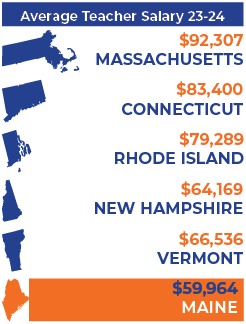
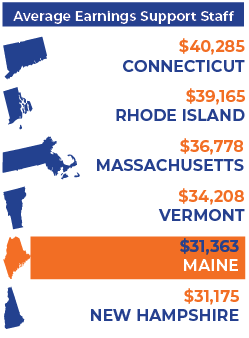
What you need to know about Faculty Pay in Maine
By Mary Ellen Flannery, NEA Senior Wrtier and Samantha Burdick, MEA. First appeared in NEA Today April 30, 2024
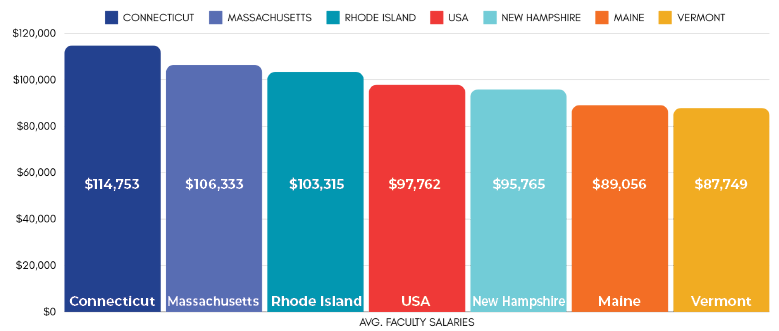
While Maine’s higher education wages increased 5.8 percent from 2022-2023, the cost of food, housing, gas, etc. increased by 6 percent over the same time. Consequently, faculty’s purchasing power actually declined by 1.6 percent. This comes on top of a 5 percent decline in purchasing power in the previous year.
Today, it’s almost impossible for younger faculty members to buy homes, says Lisa Botshon, president of the University of Maine Augusta chapter of the NEA-affiliated Associated Faculties of Maine. “Housing costs are high, and not only that, here in Maine, it’s a very closed market for rentals. It’s really a very stressful situation,” she says—and it’s particularly hard on those with small children who also must pay the rising costs of childcare.

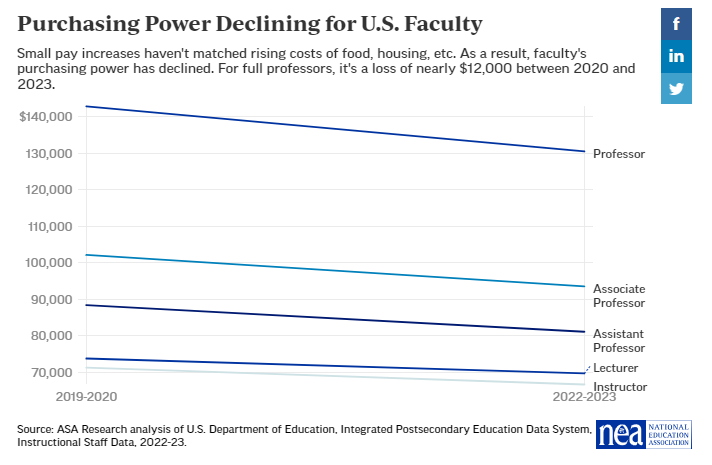
As University of Maine faculty go to the bargaining table this year, Botshon is looking for state legislators to step up. “As in many states, [Maine’s legislature] is contributing significantly less to the university system than it was two decades ago. One of the results is this lack of investment in faculty,” she says.

“[This work] already requires a tremendous amount of time and creativity, and that’s great-if you’re supported.”
Lisa botshon
University of maine at augusta
As University of Maine faculty go to the bargaining table this year, Botshon is looking for state legislators to step up. “As in many states, [Maine’s legislature] is contributing significantly less to the university system than it was two decades ago. One of the results is this lack of investment in faculty,” she says.
And the results of that lack of investment? It’s harder to hire new faculty, and it’s harder for current faculty to inspire, motivate, engage, and serve students. “[This work] already requires a tremendous amount of time and creativity, and that’s great—if you’re supported,” says Botshon. “If you’re not, and if you’re stressed out about the material conditions in which you’re working, you are not your best self in your classroom. [UM Augusta] is a teaching institution, and we are super dedicated to our students. It’s very frustrating when we can’t be there for students in the way we want to be. It’s clearly about public support—are we invested in our students or not?”
Unions Made a Huge Difference
The data is clear: faculty who teach at colleges or university with faculty unions are paid more money than non-union faculty, even in the same states.
The Union Difference
Unionized faculty who collectively bargain for better pay are paid much more (nearly $20K at community colleges) than non-union faculty in the same states. Meanwhile, faculty in non-union states are paid the least.
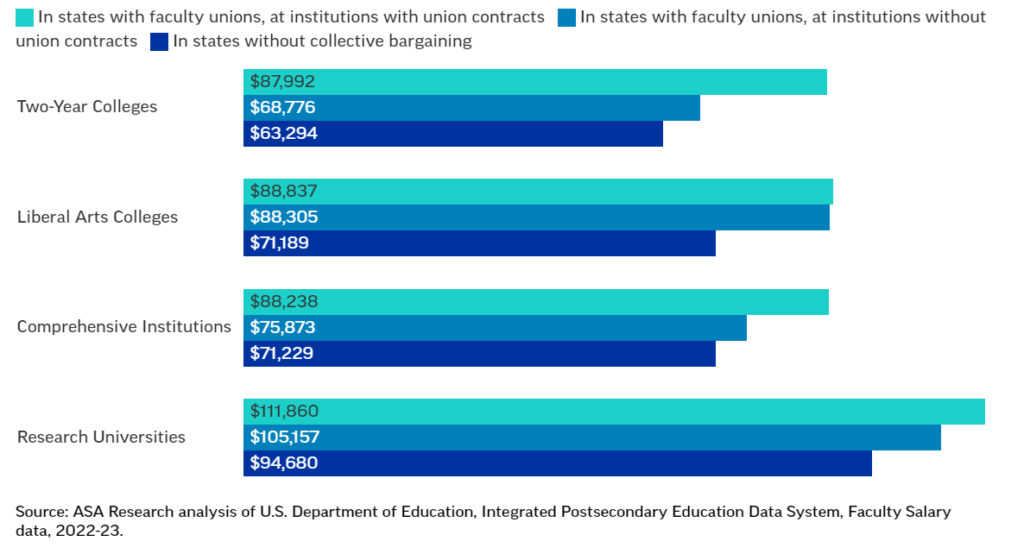
Community college faculty see the largest advantage: at 2-year colleges, faculty who collectively bargain for their pay earned $19,000 more than their colleagues who worked in the same states but without union contracts in 2023, and they earned $25,000 more than 2-year faculty in states without collective bargaining. At research universities, the difference is also significant: union faculty earned $7,000 more, on average, than non-union faculty in the same states, and $17,000 more than their peers in states without collective bargaining.


